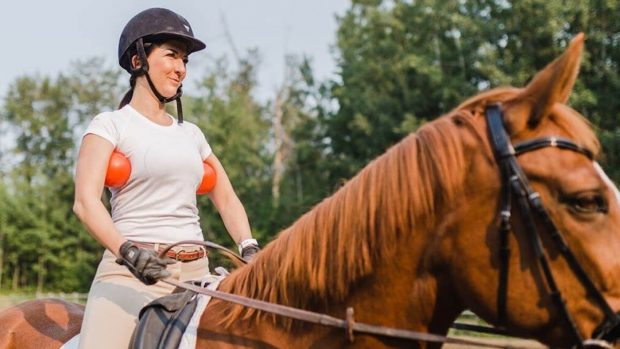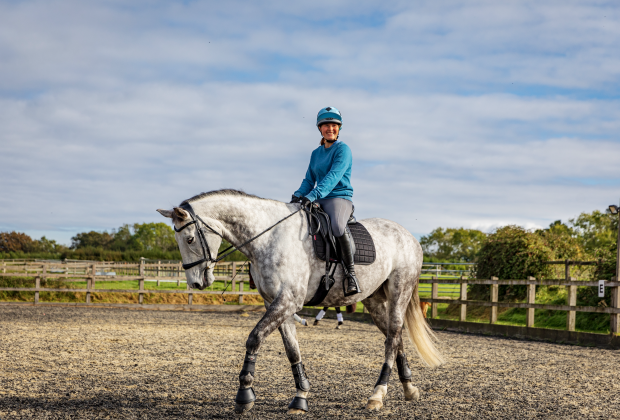Many equestrian people are familiar with ‘carrot stretches’ which veterinary physiotherapists often call dynamic mobilisation exercises (DMEs). This blog will give a little insight into the effect of this form of exercise on the horse and why DMEs are a brilliant adjunct to your training in order to keep your horse strong, flexible and to prevent injury.
Dynamic mobilisation exercise is a term given to “core stability exercises for horses” by researchers looking at ways in which to increase spinal and postural stability. It has been demonstrated that by carrying out DMEs on a regular basis, it is possible to improve the size and strength of multifidus.
Multifidus is a small, postural muscle that crosses 3-5 vertebrae connecting one to the next throughout the neck and spine, supporting localised spinal stability.
A common finding in both people (the human multifidus also provides spinal stability) and horses with back pain is that multifidus becomes atrophied (wasted). When it becomes atrophied it is often the larger spinal muscles such as longissimus and iliocostalis (the muscles you can feel either side of the horse’s spine) that are recruited to support spinal stability, working harder than they should. Their job is to provide global spinal movement rather than stability, and overuse in trying to achieve this can cause shortening and tightness, which over time can cause spasm and/or pain.
Longissimus acts to extend the horses back and is important for many reasons such as lifting the front end of the horse in the canter as the hind leg moves under the horse and supporting bringing the front end up in preparation to jump. Overuse and shortening of this muscle can cause discomfort and also inhibit the horse’s ability to round and flex up through the back, making the horse more hollow and less able to engage the core and soften into a contact.
Research has shown that DMEs strengthen the multifidus muscle which in turn supports improvements in postural stability. This can only be of benefit in the maintenance of normal movement patterns and preventing discomfort from muscular compensations (such as recruiting more global spinal muscles as described above) that may occur as a result of weakness in postural stability. DMEs also have the benefit of stretching soft tissue and maintaining comfort and flexibility throughout the neck and back. For horses with back pain, atrophy of multifidus will not necessarily be reversed without targeted rehabilitation and therefore, incorporation of DMEs to support improvement in localised spinal stability is deemed a key part of physiotherapeutic rehabilitation.
There are a number DMEs that can be carried out, with each exercise targeting a different area of the vertebral column. The lower the head position the more caudal (further from the head) the effect on spinal stability. For example, chin to chest targets the top and mid neck, whereas chin between fetlock targets the base of the neck and thoracic region).
Here are some example dynamic mobilisation exercises that you can carry out with your horse. Aim to carry out 3-5 repetitions daily, holding each position for around five seconds. To begin with, you may find that your horse struggles to gain full range but over time will begin to increase in flexibility.
Continued below…
Like this? You might also enjoy reading these:
Nina Wareham’s physiotherapy blog: engagement and core strength — why they are important for your horse
Nina Wareham’s therapy blog: why horses and humans really aren’t that different
Nina Wareham’s brand new physiotherapy blog: Welcome!
For a more extensive and tailored exercise program, it is encouraged to seek support from your local chartered veterinary physiotherapist. Furthermore, if your horse shows any signs of discomfort, or difficulty in carrying out these exercises, please seek support from you veterinarian or local chartered physiotherapist.
1. Chin to chest

Using a carrot or treat, encourage the horse to bring its chin to its chest.
2. Chin to fetlock

I find it easier to have a treat in both hands for this one. You can guide the horses nose done with the treat in the left hand and then bring the right hand between the fetlocks to give the horse the treat in the final position.
3. Chin to flank

Encourage your horse around to the side trying not to let the horse twist at the poll, the bend should come from the neck. There will also be an element of thorocolumbar bend. Aim to get your horse’s nose as far back and as close to the body as possible without allow a twist at the poll.
4. Chin to hind fetlock

Again use the treat to encourage side bend but into a low set position aiming towards the hind fetlock.
Nina




